Apple Vision Pro review: The infinite desktop
Author: John Doe
Posted on: 17 Feb 2024

In 2000, Paradox Press published “Reinventing Comics: How Imagination and Technology Are Revolutionizing an Art Form.” The book was Scott McCloud’s follow-up to his seminal 1993 work, “Understanding Comics: The Invisible Art.” Where the earlier title explored the history and visual language of sequential art, the second volume finds the medium at a crossroads. The turn of the millennium presented new technologies that threatened to upend print media.
Along with exploring existing vocabulary, McCloud coined a few terms of his own. Far and away the most influential of the bunch was “infinite canvas,” which the author explains thusly:
There may never be a monitor as wide as Europe, yet a comic as wide as Europe or as tall as a mountain can be displayed on any monitor, simply by moving across its surface, inch-by-inch, foot-by-foot, mile-by-mile . . . In a digital environment there’s no reason a 500 panel story can’t be told vertically — or horizontally like a great graphic skyline.
The infinite desktop
 Image Credits: Apple
Image Credits: Apple
As the realities of corporate control settled into the internet, the notion of infinite canvas has somewhat fallen out of popular memory (inhabit a medium long enough and you’ll eventually bump up against its boundaries). Over the past eight months, however, the term is creeping back into popular use, courtesy of Apple. The company loves a catchy slogan — and they think you’re going to love it, too. McCloud’s term presciently touches upon some of the larger paradigm shifts the company is hoping to foster with its new $3,500 headset.
“Vision Pro creates an infinite canvas for apps that scales beyond the boundaries of a traditional display and introduces a fully three-dimensional user interface controlled by the most natural and intuitive inputs possible — a user’s eyes, hands, and voice,” Apple wrote in the first Vision Pro press release.
But where McCloud’s conception of the infinite canvas specifically applied to breaking free of the paper page by embracing the monitor, Apple’s vision of “spatial computing” is an effort to go beyond that monitor. In some ways, the product succeeds brilliantly, but in much the same way that holding your hands up in one of Apple’s “Virtual Environments” displays artifacting, that vision is currently still rough around the edges.
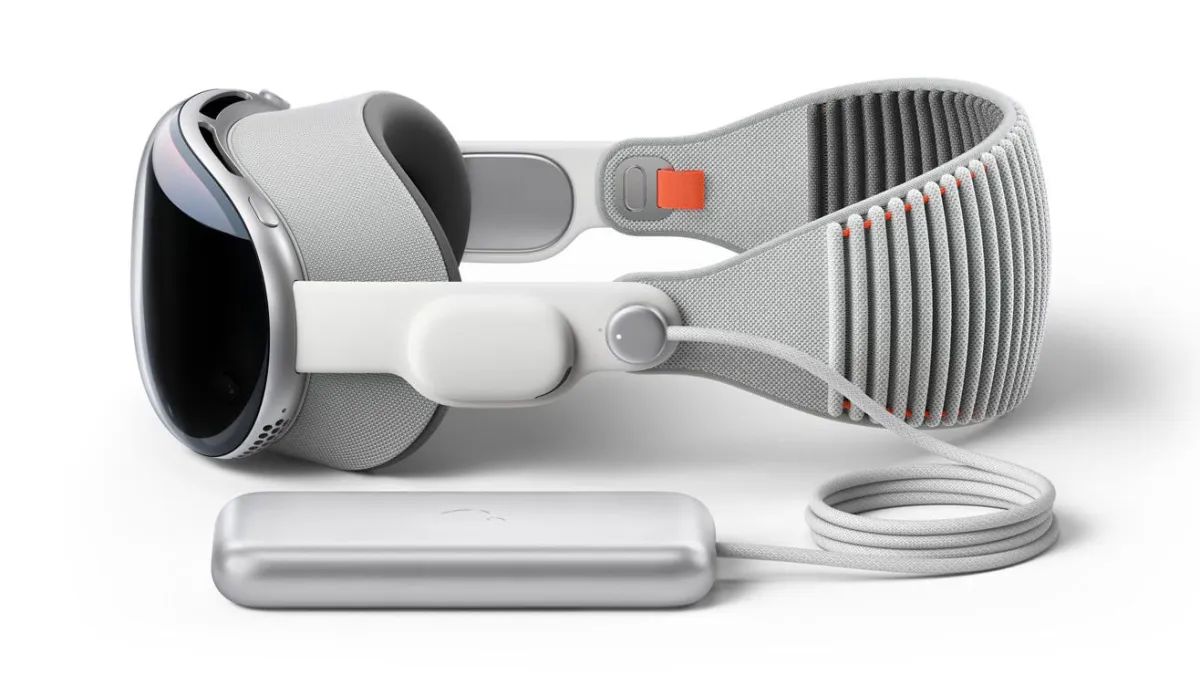 Image Credits: Apple
Image Credits: Apple
One thing to remember when discussing the Vision Pro is that it’s a first-generation product. The notion of first-gen products carries a lot of baggage — both good and bad. On the positive side is ambition and excitement — the glimpses of the future that flash in front of your pupils in beautiful 4K. On the opposite end is the very real notion that this is the first volley in a much larger, longer war. First steps are often fraught with peril.
“A journey of a thousand miles begins with a single step,” according to a common paraphrase of an old Chinese proverb. But maybe The Proclaimers put it best: “Da-da dum diddy dum diddy dum diddy da da da.”
 Image Credits: Cory Green/Yahoo
Image Credits: Cory Green/Yahoo
Another thing that needs to be stressed in any conversation about Apple’s first foray into the world of spatial computing is that it’s bold. When I did a TV interview about the product yesterday, the host asked me whether I agreed with Apple’s sentiment that this was their most ambitious product to date. Surely, he suggested, it couldn’t be more ambitious than the iPhone a decade and a half ago.
I hesitated for a moment, but I now feel comfortable saying that the Vision Pro is — in some key ways — the more ambitious product. The iPhone was not the first truly successful smartphone. The precise origin point is somewhat nebulous, depending on shifting definitions, but devices from companies like BlackBerry and Nokia came first. I might also point out that the App Store was created for the iPhone 3G the following year. None of this diminishes the truly transformative impact the original handset had on both the industry and the world (you would be a fool to deny such things), but there were plenty of popular smartphones in the world by the time the iPhone arrived in 2007.
The future of multitasking?
 Image Credits: Cory Green/Yahoo
Image Credits: Cory Green/Yahoo
In the headset’s current iteration, games are not the primary driver. The company instead presented a future wherein the Vision Pro is, in essence, your next Mac. The infinite canvas of Apple’s design is more of an infinite desktop. There’s a sense in which it serves as a reaction to the smartphone’s multitasking problem. It certainly feels as though we’ve reached the upper limits of smartphone screen size (admittedly not the first time in my career that I’ve suggested this). This is why, suddenly, foldables are everywhere.
The Vision Pro paints a picture of a world in which your computer’s desktop is limited only to the size of the room you’re in. Of all the consumer headsets I’ve tried, Vision Pro offers the most convincing sense of points in space. This may not sound like a big thing, but it’s foundational to the experience even more so than those high-res displays. I’ve tried plenty of headsets over the years that promised a movie theater in a compact form factor. Sony, in particular, has been intrigued by the notion.
Those experiences feel exactly like what they are: a small display mounted in front of your eyes. From this perspective, I wholly understand early criticism that the product is effectively like having an iPhone strapped to your face. When people tell you that you have to experience the Vision Pro to appreciate what it can do, this is what they’re talking about.
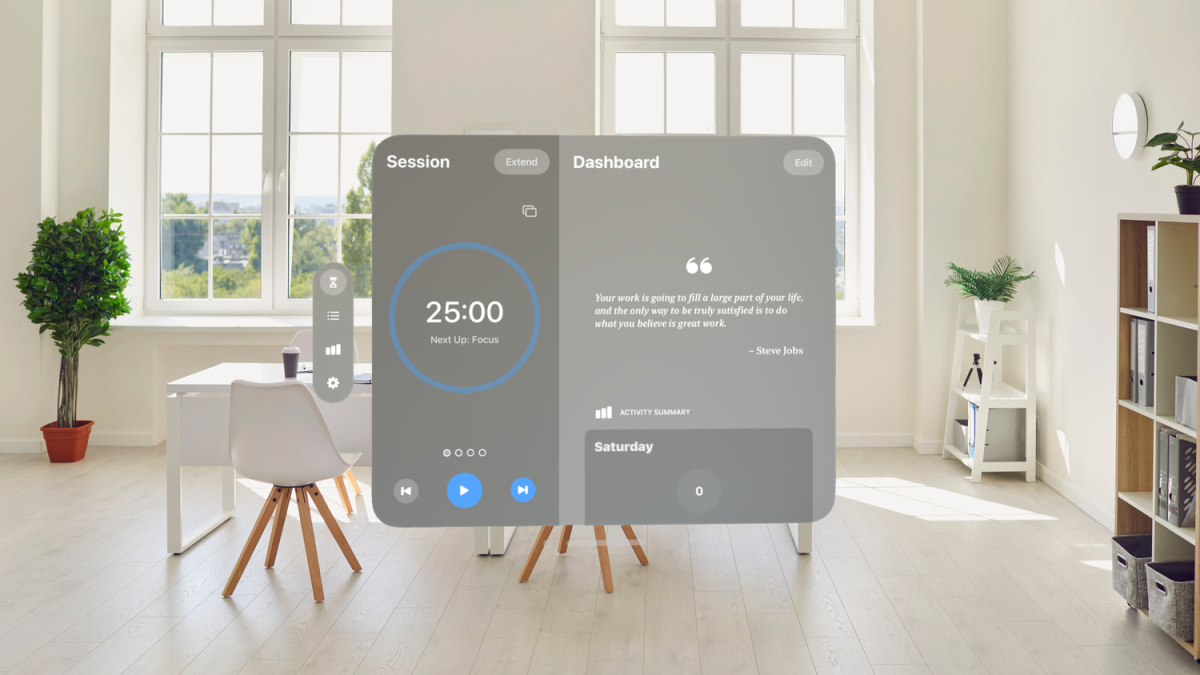 Image Credits: Meaningful things
Image Credits: Meaningful things
This is the core of spatial computing — and by extension, the Vision Pro. It’s the “Minority Report” (really need to update my pop culture references) thing of picking up and moving computer files on a three-dimensional space in front of you. Here that means I can be sitting at my coffee table banging out an email on a Bluetooth keyboard, open Apple music and stick it off to the side. If I really want to go into multitasking overdrive, I can wallpaper my room in windows.
This is one of the most interesting contrasts at the center of the experience. It’s neat, but it’s not, you know, sexy. It’s an extension of desktop computing that is potentially the future of multitasking. There are absolutely people for whom the phrase “the future of multitasking” presents the same frisson I get when I put on an Alice Coltrane record, but for most of us, multitasking is a necessary evil. If the Vision Pro is, indeed, the future of the Mac, then its ultimate destination is as a utility or tool.
It’s the device you use for document writing, email, Zoom and Slack. And then, at the end of the day, you watch “Monarch” on Apple TV or play a bit of the new Sonic game on Apple Arcade. What it decidedly is not at present, however, is the wholly immersive gaming experience of a “Ready Player One.”
Mac to the future
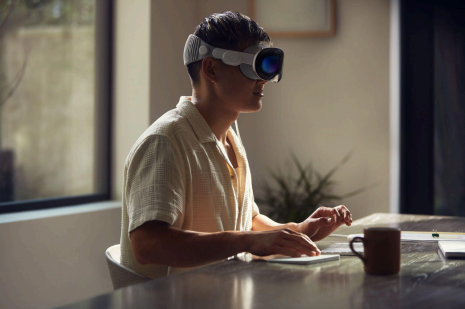
No one can do ecosystems like Apple. It’s a big part of the reason why many most people don’t stop at a single product. Once Apple gets its hooks in you, you’re done. I remain convinced that the threat of green bubbles is one of the primary drivers of iPhone sales. The company has long prided itself in the way its devices work together. This is a big benefit of developing both hardware and software. That phenomenon has only accelerated when the company started building its own chips in-house.
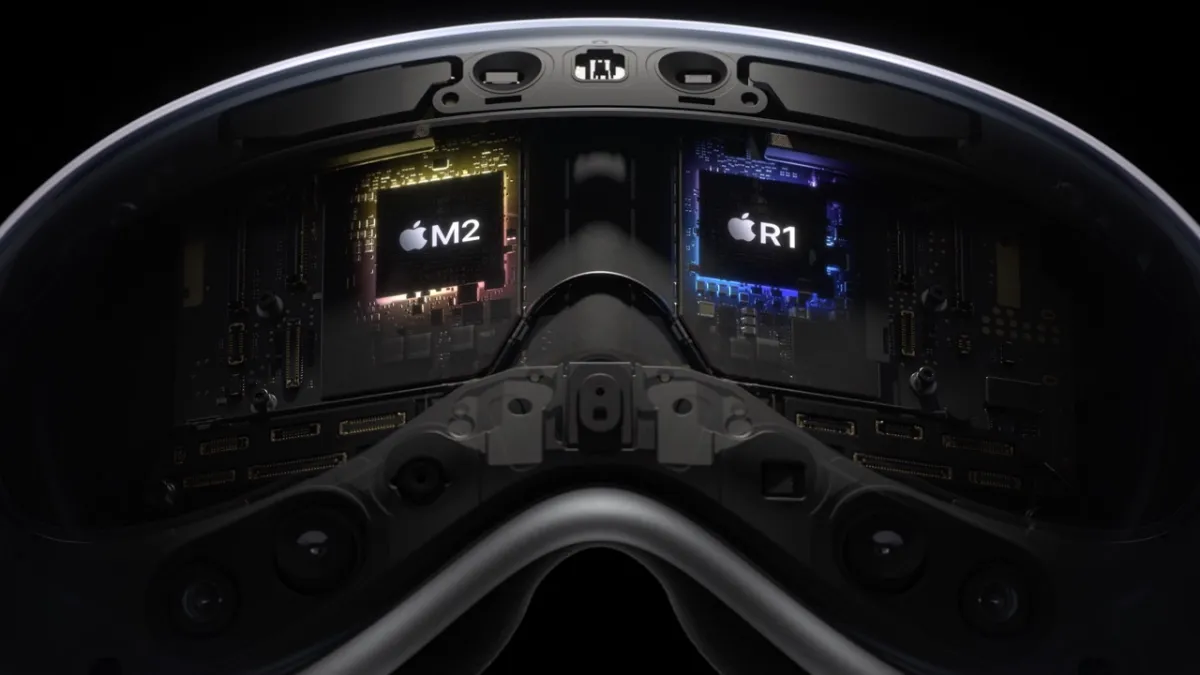 Image Credits: Apple
Image Credits: Apple
For the record, the Vision Pro sports an M2 (along with the new R1 chip, which does the heavy lifting of processing the device’s various sensors). Courtesy of Apple’s annual release cadence, that’s now last year’s chip. But for what the headset requires, it’s plenty capable. The Vision Pro is an interesting entry into the Apple ecosystem, in that it operates both as its own computing device and as an extension of the Mac. From that standpoint, it’s perhaps a logical extension of a feature like Sidecar, wherein an iPad can double as a secondary laptop Display.
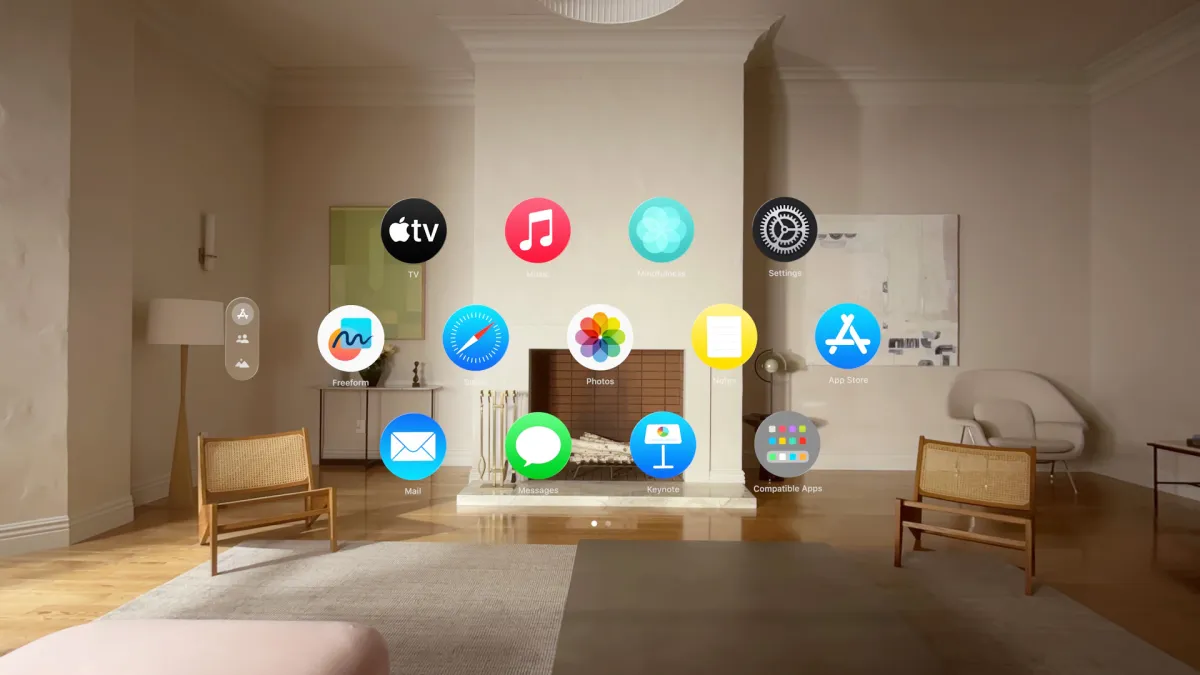 Image Credits: Apple
Image Credits: Apple
When you first receive the Vision Pro, the system will walk you through a brief onboarding process. It’s mostly painless, I promise. First, three circles of dots will appear, each with brighter light than the last. Here you’ll have to look at each while pinching your thumb and index fingers together. This helps calibrate eye tracking.
Next, the system asks you to hold up the front and then back of your hands to calibrate that tracking. You’ll be asked to pull the headset off to take a scan of your face. The process is almost identical to enrolling in Face ID on your iPhone. But first, a short introductory video.
The face-scan process utilizes the camera on the front of the visor to construct a shoulders-up 3D avatar. Look forward. Turn your head to the side. Then the other. Look up and rotate down. Look down and rotate up. Find some good lighting. Maybe a ring light if you have one. If you wear glasses, make a point not to squint. I apparently did, and now my Persona looks like it spent the last week celebrating the Ohio’s Issue 2 ballot measure.
This is where your Persona is born. Put the headset back on, hold your breath, pray for the best and plan for the worst. This 3D avatar approximation of your shoulders up is designed for teleconferencing apps like FaceTime and Zoom. Keep in mind, you’re wearing a visor and there’s no external camera pointing at you, so Apple will go ahead and do its best to rebuild you, somewhere within the deepest depths of the uncanny valley.
Passthrough
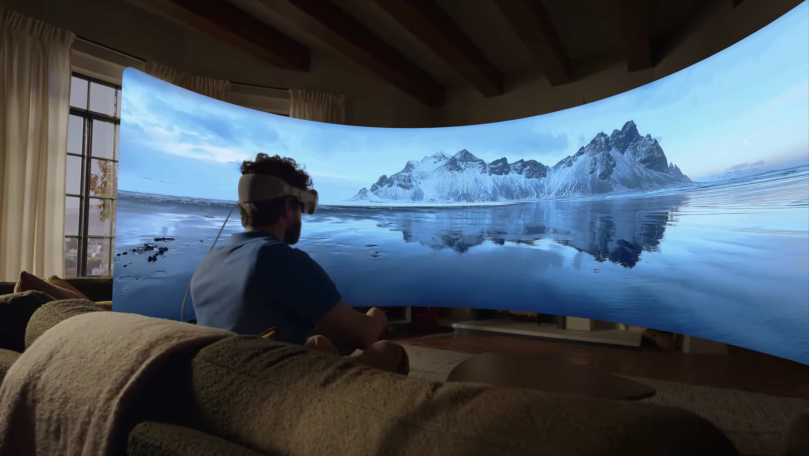
The first great consumer VR experience I can recall having involved an HTC Vive at, of all places, the Las Vegas Convention Center. It was the longest, hardest CES I ever covered. Just an absolute nightmare. I walked as much of the floor as humanly possible and filed 100 stories over the course of four days (I cannot attest to the quality of any).
As my time at the show was drawing to a close, I tried the Vive for the first time. Suddenly, I was underwater. A few moments later, a life-size blue whale swam by for a closer look. Momentarily coming eye to eye with likely the largest animal to ever exist on this planet was a humbling and genuinely transportive experience. It was a warm bath on a cold winter day that you know you have to leave at some point, but that doesn’t make it any easier.
In a piece I wrote about the Vision Pro earlier this month, I described the phenomenon of “Avatar Depression,” noting, “Not long after the film’s release, CNN reported on a strange new phenomenon that some deemed “Avatar Depression.” The film had been so immersive, a handful of audience members reported experiencing a kind of emptiness when they left the theater, and Pandora along with it.”
For all its various first-gen shortcomings, the Vision Pro offers glimpses of truly transformative brilliance. As I noted earlier this week in my piece on the power of mindfulness apps:
There are moments while using it that feel like a porthole into a different world and — just maybe — the future. It’s imperfect, sure, but it’s an undeniable accomplishment after so many decades of extended reality false starts. Using the headset for even a few minutes is a mesmerizing experience but, perhaps more importantly, offers tangible glimpses into where things are going.
Thus far, I’ve encountered multiple experiences that have given my brain the warm bath. This is partly because the Vision Pro is neither fully an AR or VR experience. It’s MR (mixed reality). The company is able to walk the line courtesy of passthrough technology, which utilizes front-facing cameras to capture an image of the world around you in as close to real time as is currently possible (the latency is around 12 milliseconds at present).
Passthrough is necessary due to the opacity of the visor (the same reason why the company relies on the EyeSight feature to let people around you know when you’re looking at them). The opaque visor is, in turn, necessary for a fully immersive VR-like experience.
The next 10 years
When I look at my Persona, I sometimes have to squint to see myself reflected back at me. In some ways, this is an apt metaphor for the space the first-gen Vision Pro occupies. Once you really start engaging with the product, you begin to see the seeds of a truly revolutionary technology. Apple has, without question, pushed the state of the art.
More than anything, the Vision Pro is the first step in a much longer journey. The company will need to hit many important stops to get there, including scaling production to a point where the optics don’t make the system prohibitively expensive, making tweaks to Personas and passthrough and properly incentivizing the developers it encounters along the way.
When I look at my Persona, I sometimes have to squint to see myself reflected back at me. In some ways, this is an apt metaphor for the space the first-gen Vision Pro occupies. Once you really start engaging with the product, you begin to see the seeds of a truly revolutionary technology. Apple has, without question, pushed the state of the art.
More than anything, the Vision Pro is the first step in a much longer journey. The company will need to hit many important stops to get there, including scaling production to a point where the optics don’t make the system prohibitively expensive, making tweaks to Personas and passthrough and properly incentivizing the developers it encounters along the way.
When I look at my Persona, I sometimes have to squint to see myself reflected back at me. In some ways, this is an apt metaphor for the space the first-gen Vision Pro occupies. Once you really start engaging with the product, you begin to see the seeds of a truly revolutionary technology. Apple has, without question, pushed the state of the art.
More than anything, the Vision Pro is the first step in a much longer journey. The company will need to hit many important stops to get there, including scaling production to a point where the optics don’t make the system prohibitively expensive, making tweaks to Personas and passthrough and properly incentivizing the developers it encounters along the way.